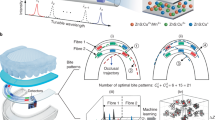Abstract
A disconnect is frequent regarding the length of time a person claims to have brushed their teeth and the actual duration; the recommended brushing duration is 2 min. This paper seeks to bridge this particular disconnect. We introduce YouBrush,—a low-latency, low-friction, and responsive mobile application—to improve oral care regimens in users. YouBrush is an IOS mobile application that democratizes features previously available only to intelligent toothbrush users by incorporating a highly accurate deep learning brushing detection model—developed by Apple’s createML—on the device. The machine learning model, running on the edge, allows for a low-latency, highly responsive scripted-coaching brushing experience for the user. Moreover, we craft in-app gamification techniques to further user interaction, stickiness, and oral care adherence.
Access this chapter
Tax calculation will be finalised at checkout
Purchases are for personal use only
Similar content being viewed by others
References
createml. https://developer.apple.com/documentation/createml. Accessed Apr 2022
createml sound classifier. https://developer.apple.com/documentation/createml/mlsoundclassifier. Accessed Apr 2022
freesound.org. https://en.wikipedia.org/wiki/Freesound. Accessed 25 July 2022
Swift programminmg language. https://developer.apple.com/swift/. Accessed 28 July 2022
Camalan, S., et al.: Convolutional neural network-based clinical predictors of oral dysplasia: class activation map analysis of deep learning results. Cancers 13(6), 1291 (2021)
Chang, Y.C., et al.: Playful toothbrush: ubicomp technology for teaching tooth brushing to kindergarten children. In: Proceedings of the SIGCHI Conference on Human Factors in Computing Systems, pp. 363–372 (2008)
Chen, Z., et al.: Unobtrusive sleep monitoring using smartphones. In: 2013 7th International Conference on Pervasive Computing Technologies for Healthcare and Workshops, pp. 145–152. IEEE (2013)
Chiu, C.C., et al.: State-of-the-art speech recognition with sequence-to-sequence models. In: 2018 IEEE International Conference on Acoustics, Speech and Signal Processing (ICASSP), pp. 4774–4778. IEEE (2018)
Chong, D., Zou, Y., Wang, W.: Multi-channel convolutional neural networks with multi-level feature fusion for environmental sound classification. In: Kompatsiaris, I., Huet, B., Mezaris, V., Gurrin, C., Cheng, W.-H., Vrochidis, S. (eds.) MMM 2019. LNCS, vol. 11296, pp. 157–168. Springer, Cham (2019). https://doi.org/10.1007/978-3-030-05716-9_13
Croyère, N., Belloir, M.N., Chantler, L., McEwan, L.: Oral care in nursing practice: a pragmatic representation. Int. J. Palliat. Nurs. 18(9), 435–440 (2012)
Deterding, S., Dixon, D., Khaled, R., Nacke, L.: From game design elements to gamefulness: defining“gamification". In: Proceedings of the 15th International Academic MindTrek Conference: Envisioning Future Media Environments, pp. 9–15 (2011)
Fijačko, N., et al.: The effects of gamification and oral self-care on oral hygiene in children: systematic search in app stores and evaluation of apps. JMIR Mhealth Uhealth 8(7), e16365 (2020)
Ganss, C., Schlueter, N., Preiss, S., Klimek, J.: Tooth brushing habits in uninstructed adults-frequency, technique, duration and force. Clin. Oral Invest. 13(2), 203–208 (2009)
Gemmeke, J.F., et al.: Audio set: an ontology and human-labeled dataset for audio events. In: Proceedings of IEEE ICASSP 2017. New Orleans, LA (2017)
Gerritsen, A.E., Allen, P.F., Witter, D.J., Bronkhorst, E.M., Creugers, N.H.: Tooth loss and oral health-related quality of life: a systematic review and meta-analysis. Health Qual. Life Outcomes 8(1), 1–11 (2010)
Graetz, C., et al.: Toothbrushing education via a smart software visualization system. J. Periodontol. 84(2), 186–195 (2013)
Hu, Y., Loizou, P.C.: Subjective comparison and evaluation of speech enhancement algorithms. Speech Commun. 49(7), 588–601 (2007). https://doi.org/10.1016/j.specom.2006.12.006, https://www.sciencedirect.com/science/article/pii/S0167639306001920. speech Enhancement
Janusz, K., Nelson, B., Bartizek, R.D., Walters, P.A., Biesbrock, A.R.: Impact of a novel power toothbrush with smartguide technology on brushing pressure and thoroughness. J. Contemp. Dent. Pract. 9(7), 1–8 (2008)
Karatassis, I., Fuhr, N.: Gamification for websail. In: GamifIR@ SIGIR (2016)
Kim, K.S., Yoon, T.H., Lee, J.W., Kim, D.J.: Interactive toothbrushing education by a smart toothbrush system via 3D visualization. Comput. Methods Programs Biomed. 96(2), 125–132 (2009)
Korpela, J., Miyaji, R., Maekawa, T., Nozaki, K., Tamagawa, H.: Evaluating tooth brushing performance with smartphone sound data. In: Proceedings of the 2015 ACM International Joint Conference on Pervasive and Ubiquitous Computing, pp. 109–120 (2015)
Kumarajeewa, R., Jayarathne, P.: Improving children’s oral hygiene habits in Sri Lanka via gamification. Asian J. Manag. Stud. 2(1), 98–113 (2022)
Lin, T.H., Wang, Y.M., Huang, C.Y.: Effects of a mobile oral care app on oral mucositis, pain, nutritional status, and quality of life in patients with head and neck cancer: a quasi-experimental study. Int. J. Nurs. Pract. 28(4), e13042 (2022). https://doi.org/10.1111/ijn.13042
Marcus, G.: Deep learning: a critical appraisal. arXiv preprint arXiv:1801.00631 (2018)
McFee, B., Ellis, D.P.: Better beat tracking through robust onset aggregation. In: 2014 IEEE International Conference on Acoustics, Speech and Signal Processing (ICASSP), pp. 2154–2158. IEEE (2014)
McFee, B., et al.: librosa: audio and music signal analysis in python. In: Proceedings of the 14th python in science conference, vol. 8, pp. 18–25. Citeseer (2015)
Mesaros, A.: Detection and classification of acoustic scenes and events: outcome of the DCASE 2016 challenge. IEEE/ACM Trans. Audio Speech Lang. Process. 26(2), 379–393 (2017)
Mushtaq, Z., Su, S.F.: Environmental sound classification using a regularized deep convolutional neural network with data augmentation. Appl. Acoust. 167, 107389 (2020)
Nanni, L., Maguolo, G., Paci, M.: Data augmentation approaches for improving animal audio classification. Eco. Inform. 57, 101084 (2020)
Patil, S., et al.: Effectiveness of mobile phone applications in improving oral hygiene care and outcomes in orthodontic patients. J. Oral Biol. Craniofac. Res. 11(1), 26–32 (2021). https://doi.org/10.1016/j.jobcr.2020.11.004, https://www.sciencedirect.com/science/article/pii/S2212426820301652
Raypole, C.: 5 toothbrushing FAQs. https://www.healthline.com/health/how-long-should-you-brush-your-teeth Accessed 13 July 2022
Rivers, C.M., Lewis, B.L.: Ethical research standards in a world of big data. F1000Research, 3(38), 38 (2014)
Schäfer, F., Nicholson, J., Gerritsen, N., Wright, R., Gillam, D., Hall, C.: The effect of oral care feed-back devices on plaque removal and attitudes towards oral care. Int. Dent. J. 53(S6P1), 404–408 (2003)
Scheerman, J.F.M., et al..: The effect of using a mobile application (“WhiteTeeth”) on improving oral hygiene: a randomized controlled trial. Int. J. Dent. Hyg. 18(1), 73–83 (2020). https://doi.org/10.1111/idh.12415. https://onlinelibrary.wiley.com/doi/abs/10.1111/idh.12415
Serizel, R., Turpault, N., Eghbal-Zadeh, H., Shah, A.P.: Large-scale weakly labeled semi-supervised sound event detection in domestic environments. arXiv preprint arXiv:1807.10501 (2018)
Sultan, A.S., Elgharib, M.A., Tavares, T., Jessri, M., Basile, J.R.: The use of artificial intelligence, machine learning and deep learning in oncologic histopathology. J. Oral Pathol. Med. 49(9), 849–856 (2020)
Tayebi, A., et al.: Mobile app for comprehensive management of orthodontic patients with fixed appliances. J. Orofacial Orthop./Fortschritte der Kieferorthopädie (2022). https://doi.org/10.1007/s00056-021-00370-7
Thomaz, E., Parnami, A., Bidwell, J., Essa, I., Abowd, G.D.: Technological approaches for addressing privacy concerns when recognizing eating behaviors with wearable cameras. In: Proceedings of the 2013 ACM International Joint Conference on Pervasive and Ubiquitous Computing, pp. 739–748 (2013)
Tosaka, Y.: Analysis of tooth brushing cycles. Clin. Oral Invest. 18(8), 2045–2053 (2014). https://doi.org/10.1007/s00784-013-1172-3
Underwood, B., Birdsall, J., Kay, E.: The use of a mobile app to motivate evidence-based oral hygiene behaviour. Br. Dent. J. 219(4), E2–E2 (2015). https://doi.org/10.1038/sj.bdj.2015.660
Wang, A., Yu, L., Lan, Y., Zhou, W., et al.: Analysis and low-power hardware implementation of a noise reduction algorithm. In: 2021 International Conference on High Performance Big Data and Intelligent Systems (HPBD &IS), pp. 22–26. IEEE (2021)
Wickramasuriya, J., Datt, M., Mehrotra, S., Venkatasubramanian, N.: Privacy protecting data collection in media spaces. In: Proceedings of the 12th Annual ACM International Conference on Multimedia, pp. 48–55 (2004)
Wikipedia contributors: Mel-frequency cepstrum. https://en.wikipedia.org/wiki/Mel-frequency_cepstrum. Accessed 13 July 2022
Acknowledgements
This work would not be possible without the support of Daniel Londoño, who helped us with our UI design, and Evan Boardway and Meghan Harris, who helped to implement the logic and design for the Leaderboard.
Author information
Authors and Affiliations
Corresponding author
Editor information
Editors and Affiliations
Rights and permissions
Copyright information
© 2023 ICST Institute for Computer Sciences, Social Informatics and Telecommunications Engineering
About this paper
Cite this paper
Echeverri, E., Going, G., Rafiq, R.I., Engelsma, J., Vasudevan, V. (2023). YouBrush: Leveraging Edge-Based Machine Learning in Oral Care. In: Taheri, J., Villari, M., Galletta, A. (eds) Mobile Computing, Applications, and Services. MobiCASE 2022. Lecture Notes of the Institute for Computer Sciences, Social Informatics and Telecommunications Engineering, vol 495. Springer, Cham. https://doi.org/10.1007/978-3-031-31891-7_4
Download citation
DOI: https://doi.org/10.1007/978-3-031-31891-7_4
Published:
Publisher Name: Springer, Cham
Print ISBN: 978-3-031-31890-0
Online ISBN: 978-3-031-31891-7
eBook Packages: Computer ScienceComputer Science (R0)




